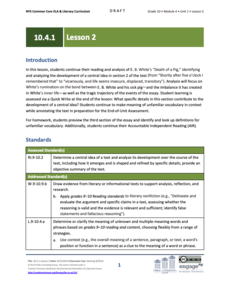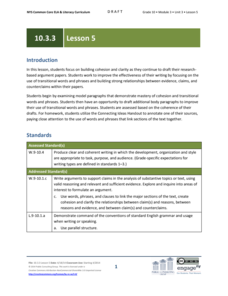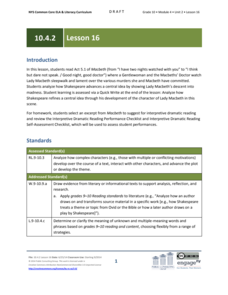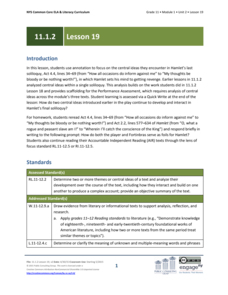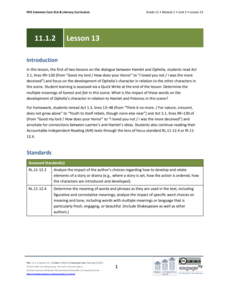EngageNY
Grade 10 ELA Module 3: Unit 1, Lesson 11
Have you had a change of heart? Scholars consider whether their views change after gaining new information about tissue ownership. They read John Moore's court hearings and respond to a quick write prompt, noting if the new information...
EngageNY
Grade 10 ELA Module 3: Unit 2, Lesson 4
Scholars take a close look at evaluating sources and the information that comes from them. Learners review their research plans, use a handout organizer to learn how to take notes, and begin annotating correctly. They practice what they...
EngageNY
Grade 10 ELA Module 3: Unit 2, Lesson 2
There are no wrong questions—or are there? Scholars learn to create practical questions to guide their research by first creating questions for their peers' research topics. They then vet classmates' questions before narrowing their...
EngageNY
Grade 10 ELA Module 4: Unit 1, Lesson 3
Are authors also designers? Scholars examine closely how E.B. White designs a section in Death of a Pig. They determine how the structure of sentences and paragraphs, the order of events, and the dialogue placement all contribute to the...
EngageNY
Grade 10 ELA Module 4: Unit 1, Lesson 2
Class members analyze the details of a section of E. B. White’s Death of a Pig to determine a central idea. Learners use turn-and-talk to discuss the details and ideas they identify. They then work in groups to annotate the text, respond...
EngageNY
Grade 10 ELA Module 4: Unit 1, Lesson 5
Learners prepare for the end-of-unit task by evaluating previous homework and writing sentences with parallel structure and various phrases. Scholars do this by closely examining E.B. White's Death of a Pig. They examine the structure of...
EngageNY
Grade 10 ELA Module 3: Unit 2, Lesson 1
Scholars work through an investigation process to narrow down a question to research. Learners begin by examining the research process, creating a portfolio, and vetting two or three possible topics. For extended work, they search for...
EngageNY
Grade 10 ELA Module 4: Unit 2, Lesson 7
One sentence, so much meaning. Scholars analyze a quote from Act 2.3 of Shakespeare's Macbeth and explore the plot in a jigsaw discussion.
EngageNY
Grade 10 ELA Module 4: Unit 2, Lesson 6
What decisions might an author make about the structure of a play? Pupils participate in an evidence-based discussion about Shakespeare's choices in Macbeth. Next, scholars analyze the effect of Shakespeare's structural choices in Act 2,...
EngageNY
Grade 10 ELA Module 4: Unit 2, Lesson 4
Ambition, murder, nontraditional gender roles ... some problems just can't be fixed in marriage counseling. Learners discuss the relationship between Macbeth and Lady Macbeth. As a culminating activity, pupils analyze how the characters'...
EngageNY
Grade 10 ELA Module 4: Unit 2, Lesson 2
What is the best way to determine the theme of a text? Pupils analyze how central ideas emerge in Shakespeare's tragedy Macbeth. They work in small groups and engage in a whole-class discussion to discuss the play's plot. Finally,...
EngageNY
Grade 10 ELA Module 3: Unit 3, Lesson 5
Can you please clarify? Scholars continue to work on their argumentative essays about selling human tissue by clarifying and adding cohesion. Writers begin by looking at model paragraphs and then begin improving their writing. They...
EngageNY
Grade 10 ELA Module 4, Unit 2, Lesson 25
How do film adaptations differ from their literary counterparts? Scholars watch and analyze the 2011 Royal Shakespeare Company (RSC) production of Shakespeare's Macbeth. Pupils complete a Quick Write analyzing how the RSC production...
EngageNY
Grade 10 ELA Module 4: Unit 3, Lesson 3
What's the difference between men and princes? Machiavelli discusses this distinction in chapter 18 of The Prince. Scholars first listen to a masterful reading of the chapter. Then, they write about how the author develops a central idea...
EngageNY
Grade 10 ELA Module 4: Unit 2, Lesson 16
How do complex characters develop throughout a text? Pupils read Act 5.1 from Shakespeare's Macbeth, which depicts Lady Macbeth's descent into madness. Using discussion and writing exercises, scholars analyze how Shakespeare develops...
EngageNY
Grade 11 ELA Module 1: Unit 3, Lesson 3
Virginia Woolf didn't believe a woman could have written Shakespeare's works. Using the resource, scholars engage in a silent discussion to analyze how Woolf uses rhetoric to convey her point of view in A Room of One's Own. Pupils write...
EngageNY
Grade 11 ELA Module 1: Unit 2, Lesson 25
Revenge, mortality, madness—what are the central ideas from Shakespeare's Hamlet? Scholars answer the question by writing multi-paragraph responses. They also identify and discuss literary devices from the play.
EngageNY
Grade 11 ELA Module 1: Unit 2, Lesson 18
How does the comparison of Hamlet to Fortinbras develop Hamlet's character? Scholars complete a Quick Write to answer the question. They also continue their exploration of Shakespeare's Hamlet, reading and discussing Act 4.4.
EngageNY
Grade 11 ELA Module 1: Unit 2, Lesson 19
If revenge is a dish best-served cold, Hamlet had better get some ice. Readers discover Hamlet's plan to seek revenge. Scholars also complete a Quick Write analyzing the central ideas in Act 4.4 of Shakespeare's Hamlet.
EngageNY
Grade 11 ELA Module 1: Unit 2, Lesson 16
Using the resource, scholars read Act 3.3 of Shakespeare's Hamlet. They analyze two soliloquies and discuss how Shakespeare develops the characters.
EngageNY
Grade 11 ELA Module 1: Unit 2, Lesson 14
How do Ophelia's interactions with Hamlet help develop her character? Pupils continue reading Act 3.1 from Shakespeare's Hamlet. Using writing and discussion, scholars analyze the dialogue between Hamlet and Ophelia, paying particular...
EngageNY
Grade 11 ELA Module 1: Unit 2, Lesson 13
What impact does word choice have on character development? Using the resource, scholars read Act 3.1 from Shakespeare's Hamlet, focusing on the development of Ophelia's character. They also complete a Quick Write to analyze the meaning...
EngageNY
Grade 11 ELA Module 1: Unit 3, Lesson 7
How might two completely different texts address similar topics and themes? Using the penultimate instructional activity from the eight-part Grade 11 ELA Module 1: Unit 3 series, scholars review the central ideas they developed in a...
EngageNY
Clarifying Thinking on Water Management: Revisiting the Gallery Walk
One, two, three, go! Scholars gather in triads and number themselves one to three. Each number is responsible for sharing a section of the map homework completed the night before as learners discuss domain-specific vocabulary terms using...
Other popular searches
- Art Lessons Primary
- Visual Art Lessons
- Visual Art Lessons Symmetry
- Elementary Art Lessons
- Compass Rose Art Lessons
- Art Lessons Primary Penguins
- Edible Art Lessons Primary
- Picasso Art Lessons
- Art Lessons Primary Easter
- 3d Art Lessons Primary
- Christmas Art Lessons
- Ceramic Art Lessons






